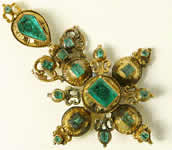
David Dixon, Kerr Sinclair and Nicholas Pearson look at the catalogue for the auction which never took place

A gold cross with 17 emeralds was part of the treasure found
Three divers accused of modern-day piracy after a shipwreck was allegedly looted are due to go on trial in Italy today (October 16).
Nicholas Pearson, a property developer from Yarmouth, David Dixon, a marine consultant from Aylsham, and Kerr Sinclair, a diver from Corton, near Lowestoft, are accused of illegally diving and damaging the wreck of the Pollux, an Italian steamship which sank off the island of Elba in 1841.
If found guilty of stealing items from the wreck and damaging the artistic and cultural patrimony of property belonging to Italy, the men face up to four years in jail.
After three weeks of diving, they had recovered 311 French and Spanish gold coins, 2,000 silver coins, some diamonds and a gold locket believed to contain a lock of Napoleon's hair. At the time of the initial police investigation in 2001, they said they had consent from both the British and Italian governments and had stumbled across the Pollux while looking for another wreck. All three had hoped the matter was at an end after spending months on police bail and paying a fine to British authorities.
Yesterday, Mr Pearson and Mr Dixon were unavailable for comment, but Mr Sinclair said: "I thought this was all over. I'm sorry for what happened, and we did give everything back.''
According to Italian prosecutors, the group travelled to Italy in 2000 then chartered a salvage ship and bought permission to retrieve tin ingots from the Glen Logan, a British merchant ship torpedoed by a U-boat off the Tyrrhenian island of Stromboli in 1916. Instead, they diverted their course 460 miles northwards, where they found the wreck of the Pollux lying at 300ft.
Prosecutor Giuseppe Rizzo alleged: "These divers tricked their way on to the wreck and submitted false paperwork. Nothing would have been known about it had the auction house not become suspicious.
"They questioned how such an extensive collection of gold and silver coins which were from France and Spain could have been on board a British merchant ship sunk in 1916."
Pascal Kainac, a French historian, also faces charges at the court in Portoferraio, on Elba, accused of supplying them with ancient maps and co-ordinates.
Reports in French newspapers at the time of the sinking said the ship had been carrying a total of £12m of goods including 100,000 gold coins and 70,000 silver ones, as well as a gold carriage belong to the Contessa de la Roccau. Its passengers included a Russian countess and a Neapolitan duchess who were carrying diamonds and emeralds.
It sank in 15 minutes after being hit by another steamship on a voyage between Naples and Marseilles. Speculation in both Italy and France suggested the other ship was manned by pirates.
